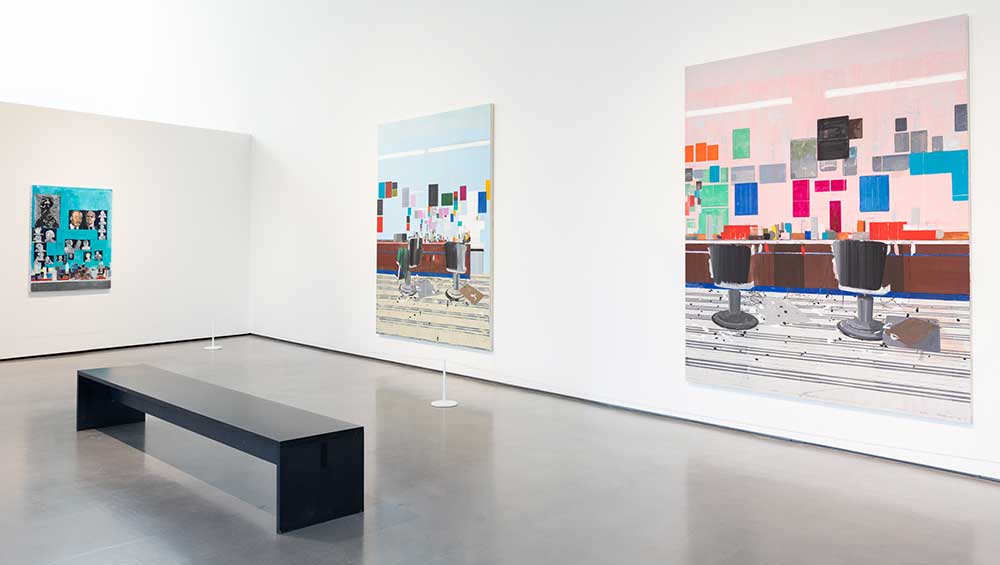
Hurvin Anderson: Salon Paintings, The Hepworth Wakefield, 26 May – 5 November 2023. Courtesy of The Hepworth Wakefield. Photo: Anya Raczka.
The Hepworth Wakefield
26 May – 5 November 2023
by BETH WILLIAMSON
Hurvin Anderson is a quiet but gently persistent voice in contemporary British painting. Born in 1965 in Handsworth, Birmingham, to Jamaican parents, the 58-year-old painter studied at Wimbledon School of Art and the Royal College of Art, London. He was nominated for the Turner Prize in 2017 and was elected as a Royal Academician this year. He now lives and works in Cambridgeshire. Anderson’s painting has long been inspired by the stories he grew up with of the Caribbean, an almost mythological place in his memory and imagination, yet marked by colonialism and present-day economic difficulties. His lush green landscapes explore the space between reality and imagination, the tension between the natural beauty of the Caribbean landscape and the realities of life there.
It was a visit to his father in Birmingham, while Anderson was living in London, that triggered his first barbershop painting. The Barbershop series began in 2006 and it is a subject that he has returned to repeatedly for more than 15 years. As an important social space for the British Caribbean community, his focus is not surprising. Still, the subject itself is just the beginning, and Anderson uses that to investigate some of the key concerns of painting today.
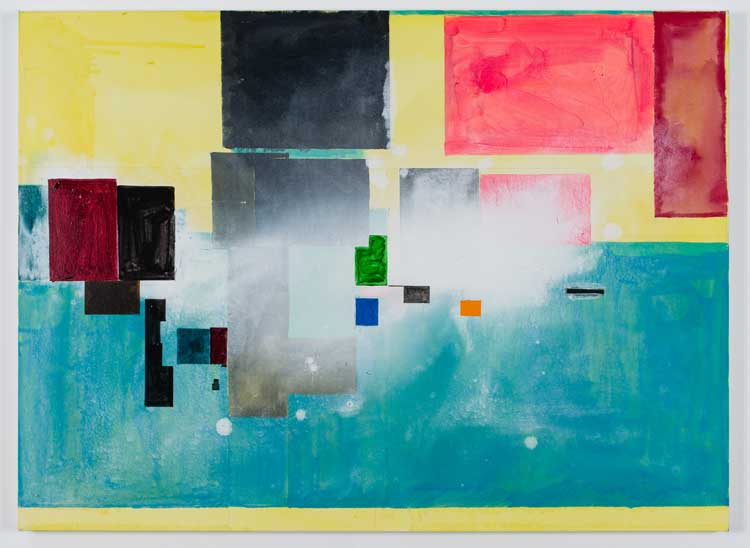
Hurvin Anderson, B.H.B, 2016. © Hurvin Anderson. Courtesy the artist and Michael Werner Gallery, New York. Photo: Richard Ivey.
There is the ever-present tension between figuration and abstraction, and the difficulties of somehow capturing recollections and experiences in a painting. For Anderson, his intricate process of making means that he approaches his subject from a remove. These barbershop interiors are not painted directly. Instead, photographs are used in a collage-like fashion to look through the space, take the room apart and reconstruct it. He recreates objects and scenes in the studio and this intriguing social space becomes both particular and generic. As Anderson explained it, he tried to make a generic barbershop, to create a space of his own that embodied all the shops that he had seen. The preparatory drawings displayed in this exhibition are wonderful to see and helpful in understanding Anderson’s process. Layers of drawings enable the artist to distance himself a little, to reassemble aspects of the scene while experimenting with pace and rhythm to create the sense of space and place he is aiming for.
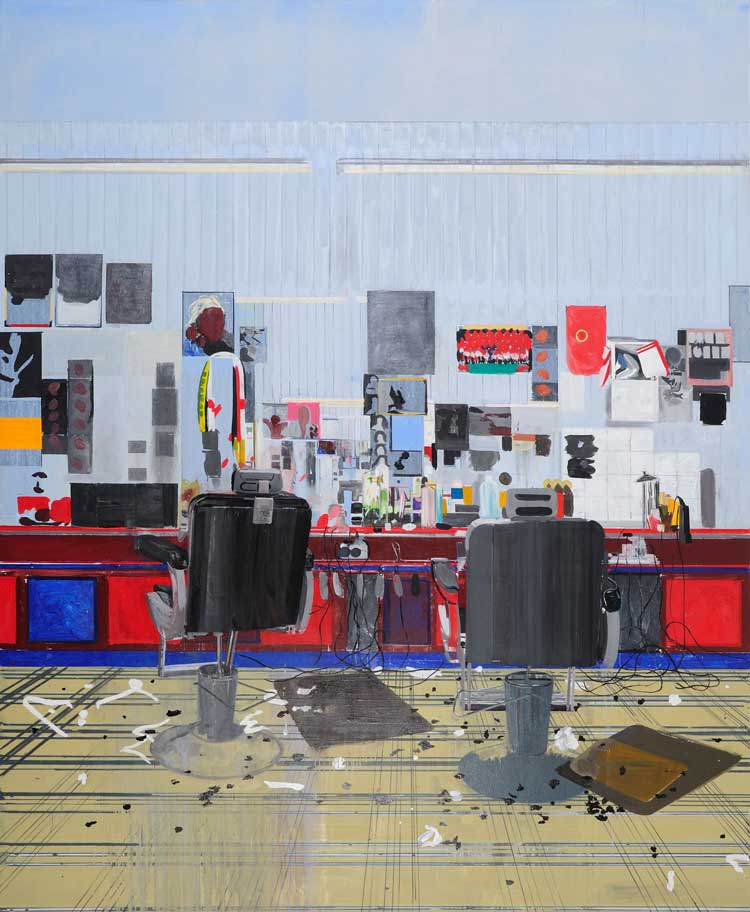
Hurvin Anderson, Afrosheen, 2009.
© Hurvin Anderson. Courtesy the artist and Thomas Dane Gallery.
Figuration and abstraction wrestle within Anderson’s pictures. In earlier paintings, such as Afrosheen (2009) or Jersey (2008), the chairs in the foreground act as a barrier, complicating entry to these spaces that look almost abandoned, with debris strewn around and without the presence of the figure. As chairs are removed and images such as Essentials (2017) or Classic-Pro (2017-23) become more abstracted, viewers can enter these imaginary spaces more easily. In Anderson’s most recent paintings such as Shear Cut and Skiffle (both 2023), the figure appears. The viewer is allowed into this space although the presence and positioning of mirrors fragments the scene, introducing a visual chaos that disappears in infinite regress. Later paintings are therefore more pared back as the barber’s chairs are removed and the counter itself dominates, a nod to the history of painting in general and to Édouard Manet’s A Bar at the Folies-Bergère (1882) in particular. You are the viewer, the barber and the client. The nature of diasporic experience is hinted at, too, through the presence of multifarious posters and flyers stuck on to the mirrors. For the most part, these are lacking in details, more a redaction of mirrored space, but hinting at the conversations and social exchanges in this charged space – Anderson mentioned talk of going back home, karate (a popular pastime among boys as he grew up) and funerals, as shared topics of conversation. The accoutrements of the barber are strewn across the counter, hair trimmings on the floor. Every now and then a plant appears that changes the pace of the image.
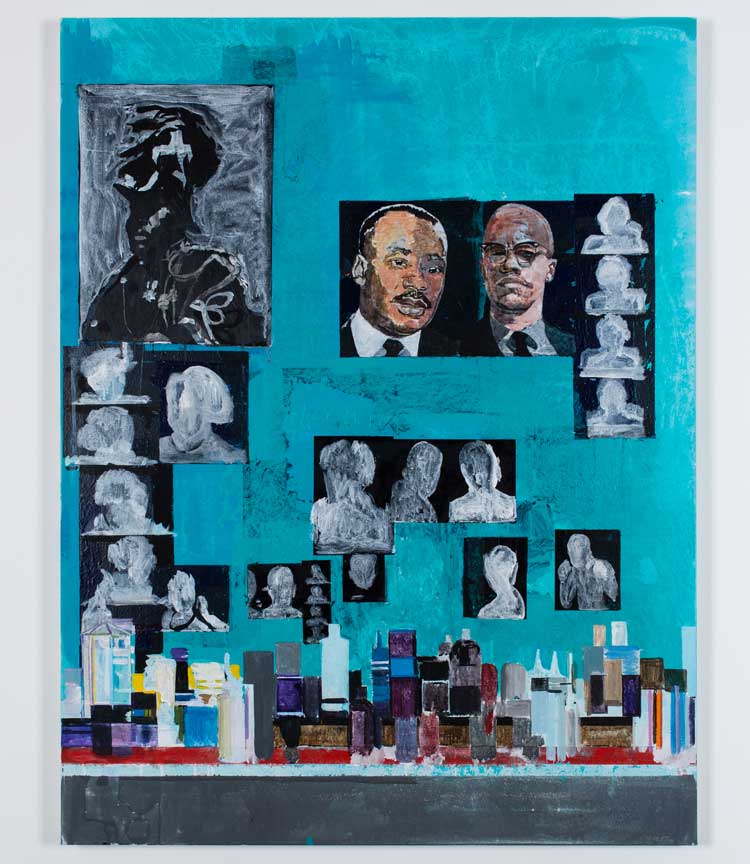
Hurvin Anderson, Is It Ok To Be Black?, 2015. A 70th Anniversary Commission for the Arts Council Collection with New Art Exchange, Nottingham and Thomas Dane Gallery, Arts Council Collection, Southbank Centre, London. © Hurvin Anderson. Courtesy the artist and Thomas Dane Gallery. Photo: Richard Ivey.
These thoughtful and poetic paintings are not without overt political commentary. In Is it OK to Be Black (2015)? Anderson includes recognisable images of Malcolm X and Martin Luther King, important in the civil rights movement, among a collection of other significant black figures in silhouette. The work’s title, as Anderson explained it, is at once serious and humorous. It refers to his mis-hearing of the ubiquitous barbershop question: “Is it all right at the back?” It also highlights the barbershop as a space for the black community.
_ph-Richard-Ivey.jpg)
Hurvin Anderson, Studio Drawing 9, 2012. © Hurvin Anderson. Courtesy the artist and Thomas Dane Gallery. Photo: Richard Ivey.
The exhibition as a whole is nicely paced including, as it does, works from 2006 through to the present day. The balance between paintings and preparatory drawings is nicely done, too, allowing the viewer to look behind the scenes, as it were. Showing multiple drawings together begins to convey something of the experimental nature of Anderson’s practice and the necessary but laborious process of deconstruction and reconstruction of space comes into view. An accompanying exhibition, Hurvin Anderson Curates, acts to illuminate his work in a wider context. For this, the artist chose 20th century paintings from UK public collections set in dialogue with important artists of the Black British Arts movement. There are works by Michael Andrews, Francis Bacon and Duncan Grant, for instance. There are also works by Keith Piper, Claudette Johnson and Denzil Forrester. These were selected by Anderson and allow visitors a unique insight into his motivations and points of reference.
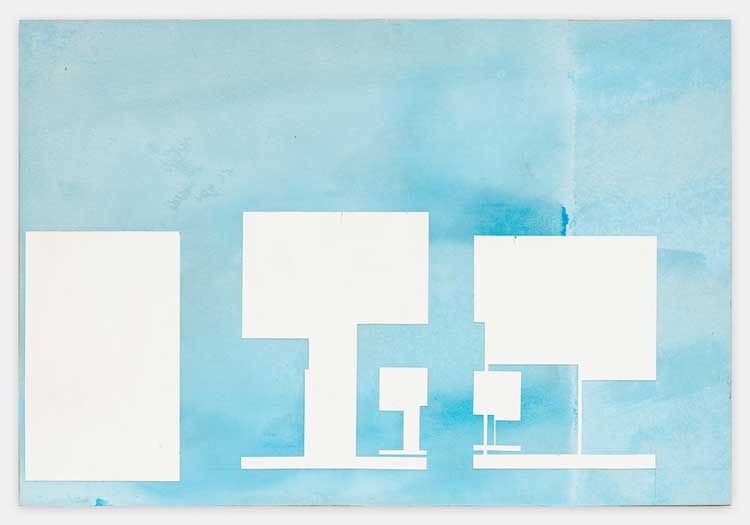
Hurvin Anderson, Lust for Life, 2011. © Hurvin Anderson. Courtesy the artist and Thomas Dane Gallery. Photo: Eva Herzog.
Of course, the significance of any particular painting may not be what it seems. His inclusion of an abstract work by Victor Pasmore caught my attention, particularly as Pasmore was the artist I immediately thought of in relation to the works in Salon Painting. When I asked Anderson about this, he explained that he selected the Pasmore work not because of its central imagery, but because of what he saw in the periphery, two dots of colour outside the main image, lingering in the border. As a concept, its not dissimilar to Anderson’s Barbershop series as he focuses on social spaces that are crucial for the Jamaican diaspora in the UK, but still exist in the margins. Anderson’s paintings shift that relationship by putting the barbershop front and centre. Perhaps this is Manet for contemporary times.